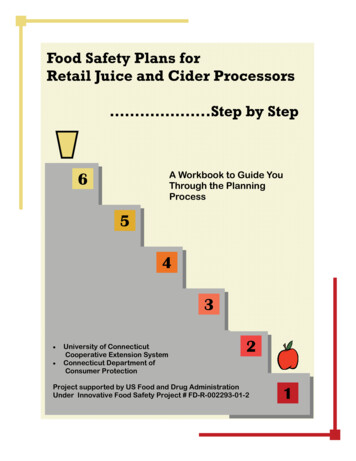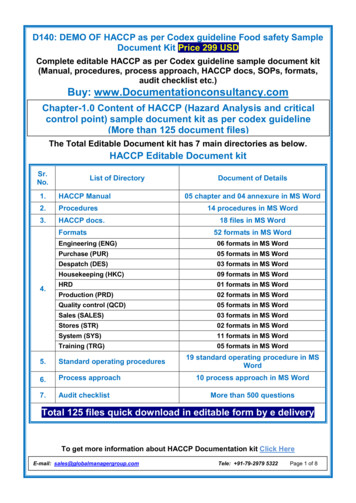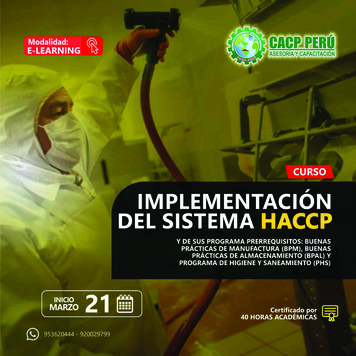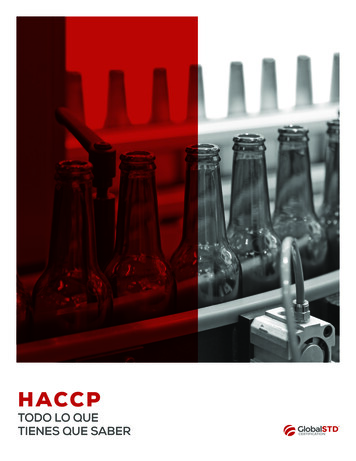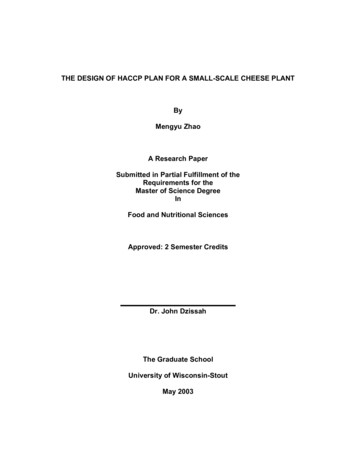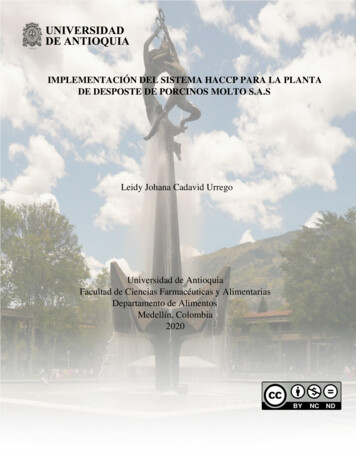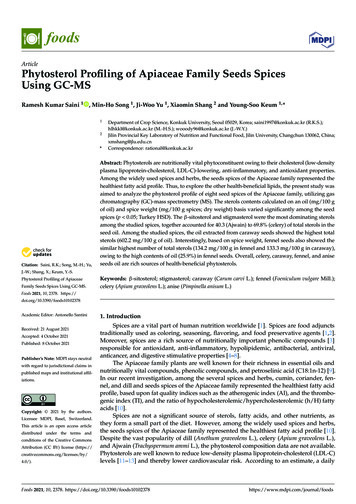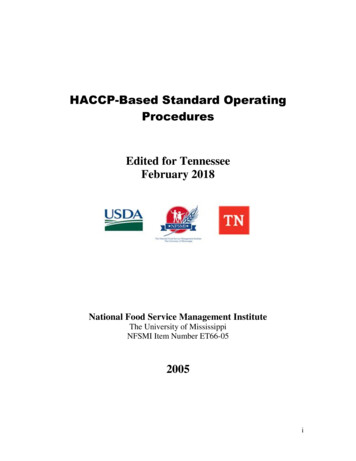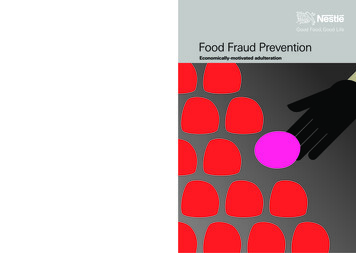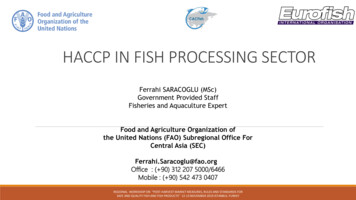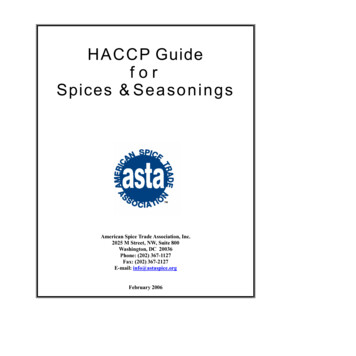
Transcription
HACCP GuideforSpices & S e a s o n i n g sAmerican Spice Trade Association, Inc.2025 M Street, NW, Suite 800Washington, DC 20036Phone: (202) 367-1127Fax: (202) 367-2127E-mail: info@astaspice.orgFebruary 2006
Copyright 2006. American Spice Trade Association, Inc. Printed in USAAll rights reserved. No part of this document may be reproduced or utilized in any form without permission inwriting from ASTA. Inquiries should be addressed to the American Spice Trade Association, Inc., 2025 MStreet, NW, Suite 800, Washington, DC 20036
Table o f C o n t e n t sIntroduction & HistoryScope, P u r p o s e a n d B e n e f i t sHAACP P r e r e q u i s i t e P r o g r a m sHACCP P r i n c i p l e sGuide f o r HAACP PLAN ImplementationHACCP P l a n D o c u m e n t a t i o nHazardsC h emic alPhysicalRecommended c l e a n i n g equipmentb i o l o g i c a l HazardsH a z a r d A n a l y s i s / S p i c e s a n d P r o c e s s e d S eas oni ngsChecklist o f QuestionsP r o d u c t Description –P r o c e s s e d Spice: B l a c k PepperF l o w DiagramWorksheetsP r o d u c t Description –P r o c e s s e d SeasoningsF l o w DiagramWorksheetsL i s t o f Ty p i c a l R e c o r d sHACCP Ve r i f i c a t i o n s / Va l i d a t i o n sRecommended HAACP M a n u a l L a y o u tD e f i n i t i o n o f TermsR e f e r e n c e s f o r HACCP TeamsS e l e c t e d web s i t e s f o r f o o d s a f e t y i n f o r m a t i o nASTA Spice M i c r o b i o l o g yB a c t e r i o s t a t i c and S y n e r g i s t i c P r o p e r t i e s o f SpicesEpidemiology & P a t h o g e n sM i c r o b i a l P r o f i l e o f Raw SpicesAl l er g en sG o v e r n m e n t R e f e r e n c e PapersF e d e r a l R e g i s t e r – P a r t II 2 1 CFR P a r t s 1 2 3 & 1 2 4 0N a t i o n a l A d v i s o r y Committee o n M i c r o b i o l o g i c a lCriteria f o r FoodsPapers P r e s e n t e d a t ASTA Te c h n i c a l F o r u m – O c t 2 0 0 2A R e g u l a t o r y O v e r v i e w – HACCP & F o o d S e c u r i t yF o o d S a f e t y Issues f o r I n d u s t r yManaging F o o d A l l e r g e n sHACCP P r e r e q u i s i t e P r o g r a m sD e v e l o p i n g a HACCP P l a 767769310311 5124130
INTRODUCTION AND HISTORYHACCP is the acronym for Hazard Analysis Critical Control Point. HACCP is the internationallyrecognized and recommended approach to ensure food safety. It is an analytical tool that enablesmanagement to introduce and maintain a cost-effective, ongoing food safety program. HACCPinvolves the systematic assessment of the steps involved in a food manufacturing operation andthe identification of those steps that are critical to the safety of the product. The analysis allowsmanagement to concentrate resources into those manufacturing steps that critically affect productsafety. A Hazard analysis will produce a list of Critical Control Points (CCPs), together withcontrol parameters (with critical limits), monitoring procedures and corrective actions for eachCCP. For continuing safety and effectiveness of the plan, records must be kept of each analysisand the efficacy of the study must be verified on a regular basis, and when aspects of theoperation change.HACCP is applicable to the identification of microbiological, chemical, and physical hazardsaffecting product safety. It may be applied equally to new or existing products. It requires the fullcommitment of management to provide the resources necessary for successful analysis andimplementation. Much of the effectiveness of HACCP is achieved through the use ofmultidisciplinary team of experts. The team should have members from relevant areas; e.g.,microbiology, chemistry, production, quality assurance, food technology, and food engineering.The HACCP system applied to food safety was developed in the 1960's jointly by Pillsbury, theUS Army Labs at Natick, and NASA in their development of foods for the American SpaceProgram. It was necessary to design food production processes to ensure the elimination ofpathogens and toxins from the foods. As this could not be achieved by finished product testingalone, the HACCP concept was initiated.In 1971, Pillsbury presented HACCP at the first American National Conference for FoodProtection and since then the concept has been evolving in the food industry. The Food andDrug Administration built HACCP into their Low Acid Canned Foods Regulations and theDepartment of Agriculture has applied HACCP to meat and poultry inspection. The WorldHealth Organization and International Commission on Microbiological Specifications for Foodshave encouraged the use of HACCP.1
SCOPE AND PURPOSEHACCP is a powerful system, which can be applied to a wide range of simple and complex operations.It is used to ensure food safety at all stages of the food chain. For manufacturers to implement HACCP,they must investigate not only their own product and production methods but also apply HACCP totheir raw material supplies, final product storage, and consider distribution and retail operations up toand including the point of consumption.The HACCP system may be applied equally to new or existing products. It should be used whenintroducing new products or new production methods or when making modifications to parts of aprocess. It may also be used to ensure the effectiveness of production support operations such as cleaningsystems.The purpose of this document is to outline HACCP principles to the spice industry and todevelop two generic models for spice industry use: 1) a processed spice, 2) a formulatedseasoning.BENEFITSThe benefits from the use of HACCP are many. Key benefits are: HACCP is a systematic approach covering all aspects of food safety from raw materials, growth,harvesting and purchase to final product use. Use of HACCP will move a company from a retrospective end product testing approachtowardsa preventative Quality Assurance approach. HACCP provides for a cost-effective control of foodborne hazards. A correctly applied HACCP study should identify all currently conceivable hazardsincluding those which can realistically be predicted to occur. Use of a preventative approach leads to reduced product losses. Use of HACCP focuses technical resources on critical parts of the process. HACCP is complementary to other quality management systems. U.S. regulatory and international authorities approve HACCP as an effective means foromcontrolling foodborne diseases.2
HACCP PREREQUISITE PROGRAMSIntroductionHACCP is not a stand-alone program but is part of a larger control system. Prerequisite programs aredefined as a range of programs/procedures used to support the HACCP program. Prerequisiteprograms are essential to the overall management of food safety issues and provide the basicenvironmental and operating conditions for a manufacturing facility. Many of these programs in theUnited States are based on Good Manufacturing Practices as listed in the Code of FederalRegulations, 21 CFR 110, or practices specified in other federal, state, and local regulations andguidelines. Many prerequisite programs are already in place in food manufacturing plants. If alreadyin place, they should be reviewed and revised as necessary. Prerequisite programs should bedeveloped, implemented, and documented before putting a HACCP plan in place.Documentation is very important for all programs. A well written program clearly lists whatprocedures should be performed, at what frequency, who has responsibility, and what actions shouldbe taken if the procedures are not performed according to the written protocol or if there are anyproblems occurring with the program.The success of both prerequisite and HACCP programs require continuing training of employees.Without complete understanding, the programs are not likely to succeed. Also, each operatingprocedure related to a program should include procedures for routine verification by someone otherthan the person assigned to complete the task.Prerequisite ProgramsFollowing is a list of prerequisite programs that typically apply to manufacturing facilities. Theprograms will vary by application to different products and processes.Premises/Facilities Building structures and utility systemsPest prevention / proofingOutside propertyWaste managementWater quality (Treatment and Testing)Air quality (Testing)The entire building structure and surrounding areas and equipment need to be considered. The goalis to minimize potential contaminants from coming into contact with the food and crosscontamination risks of different food products. For example, the building can pose a safety risk withporous surfaces, poor sanitation and maintenance. Surfaces should be non-porous and easy to clean.Buildings must have tight-fitting windows, screens, and doors. Any openings in the walls, floor, orceiling where insects, rodents, and birds can enter or hide must be cleaned. Good pest controlsystems must be in place, both inside and outside of the building. It is important that3
HACCP PREREQUISITE PROGRAMSthe areas surrounding the outside of the building be kept clean and free from debris, refuse, and otherunrelated material. Store items away from the walls. Having a clean plant or warehouse that issurround by debris will cause problems. Ensure that waste is removed from the facility without therisk of it contaminating on route and make sure its storage does not give harborage to pests.Receiving/Storage/Distribution Raw materialsReceiving/storage/distribution areasLetters of guaranteeContainer/truck inspectionHold and releaseLabel review for instructions, (e.g. “Keep Refrigerated”)Pallet controlsAll raw materials should be purchased from an approved supplier and to up-to-date specifications.All raw materials should be kept separate from finished products. Upon receipt, all raw materials,packaging, and containers/trucks should be inspected prior to acceptance. Various guarantees may berequired from suppliers. Proper environmental conditions such as temperature and humidity must becontrolled, monitored, and documented to assure raw material safety and wholesomeness.Raw materials can act as cross-contaminants to other ingredients. This is particularly important forthose products that are considered allergens. Products must be carefully segregated. Therefore,storage areas must be properly planned to minimize damage and cross-contaminations issues. It isimportant that pallets do not become a source of contamination, thus design, condition and useshould be specified.General Quality Systems/GMPs Chemical Control ProgramApproved suppliersRework practicesMacroanalytical testingMicrobiological testingEnvironmental monitoring for pathogensFormula monitoringProduct sequencingGlass and Brittle Plastic policyWritten specifications should be in place for all chemicals, ingredients, and packaging. An approvedsupplier program is helpful in controlling raw materials while assuring that the suppliers arecomplying with applicable laws, using GMPs and have food safety programs in place.4
HACCP PREREQUISITE PROGRAMSA control program for use and storage of cleaning and sanitation chemicals, fumigants, and otheritems used in or around the facility is necessary. Chemicals must be properly labeled and storedin areas separate from food storage areas. The chemical storage area should be accessible toappropriately trained personnel only.Documented systems and procedures must be in place for macroanalytical and microbiologicaltesting. Laboratories for testing, whether internal or external, should be audited on a regularbasis.TrainingThe need for HACCP training is paramount. The success of the HACCP program is dependenton nearly everyone in the company. The personnel involved in HACCP must understand theirrole within the HACCP program. Thus, those involved must understand what HACCP is, theymust have the skills necessary to make the HACCP system operate properly and also understandwhat is expected of them.Recall/Traceability Hold and releaseRecall proceduresTraceability/codingEvery company must be able to trace all raw materials and finished goods. Proper lot coding ofall materials and appropriate records are necessary. Good records may limit the amount ofmaterial to be recalled.It is recommended that trial recalls (or mock recalls) are performed on a regular basis. Typicallytarget success parameters are determined including successful recall percentage and recall timeelapsed.Equipment Performance and Maintenance Proper designPreventative maintenanceContractor controlEquipment calibrationTemporary repair proceduresEquipment should be designed to minimize the cross-contamination of food, the accumulation offood residues during the production and for ease of cleaning. If equipment is difficult to clean, orpoorly cleaned, microbiological growth can occur that will contaminate the product.5
HACCP PREREQUISITE PROGRAMSConsideration should be given to air intakes into production lines to ensure that the risk ofpotential contamination via the air flow is managed.There must be pre-scheduled servicing of all equipment, including replacement of warn parts.Schedules should also be established for equipment calibration.Pest Control-The goal of the pest control program is to primarily prevent the entry of pests into the foodplant, as well as, eliminate pests that do enter the facility. Pests include (but are not limitedto): rodents, insects and birds.The pest control activity can be carried out through a combination of pest control contractorand in-house involvement, which meets all regulatory requirements.The pest control practices that assist a company in maintaining a pest free environmentinclude (but are not limited to):- Regular inspections by a certified/licensed pest control company or employee.- A process that eliminates pests and/or circumstances which permitted a pest presence, ifpests are found.- Follow-up to verify effective elimination of pests and circumstances that permitted apests presence.- Utilization of approved chemicals and baits, according to written procedures.- Thorough documentation of pest control activity.- Analysis of trends to monitor and optimize performance of the Pest Control Program.- On-going training program for company personnel to keep them up to date withregulatory and technical developments in pest control.Sanitation Program-The goal of a sanitation program is to maintain a sanitary environment, necessary for theproduction of food of the highest quality and safety.The sanitation program encompasses all working areas and equipment utilized in themanufacture or warehousing of food products.A company will maintain documented sanitation procedures.Written sanitation procedures and forms for each cleaning task typically include (but are notlimited to) the frequencies, sequence of steps involved, tools and utensils used, approvedmaterials and documentation requirements.Sanitation procedures will be used as tools for training new personnel, as well as, forrefresher training of existing employees.6
HACCP PREREQUISITE PROGRAMSAllergen Control-The ultimate goal of the Allergen Control Program is to protect consumers with foodrelated allergies.This is accomplished through, but not limited to: ingredient review, labeling, rework,segregation, scheduling, sanitation and training.Procedure(s) outlining allergen ingredient review, labeling, rework, segregation,scheduling, sanitation and training will be documented.Process ControlTo ensure that the manufacturing environment does not add to the risk of introducing a hazardinto the product there can be programs to ensure this contamination controlled or eliminated.Process control procedures can include but are not limited to:-Bag opening controls – to ensure that raw material packaging does not introduce a potentialhazard.Knife control programs – to ensure correct sanitation and identification of potential breakage.Control of bag stitching needles – to ensure that a broken needle does not get into the productControl of magnets – to ensure they are cleaned and maintained correctlyControl of utensil, such as brushes and scoops, to ensure they remain in good condition andare not a risk for cross contamination (particularly allergens)Sampling procedures – to prevent contamination and to ensure that sampled product iscorrectly sealedControl of screens / sieves – to ensure that they do not break and become potentialcontaminants and to ensure that they remain undamaged.PersonnelProcedures should be in place to ensure that all personnel entering the manufacturingenvironment do not pose a risk to food safety. Some of the personnel programs may include:- Hand washing / sanitation controls- Protective clothing regimes- Company hygiene code- Return to work procedure- Visitor controlsAs an example the company hygiene code may include such items as eating and drinkingprocedures, smoking controls, illness reporting, removal of jewellery, etc.7
HACCP PRINCIPLESHACCP is a system which identifies specific hazard(s) (i.e. any biological, chemical, or physicalproperty that adversely affects the safety of the food) and specifies measures for their control.The system consists of the following basic seven principles (National Advisory Committee onMicrobiological Criteria for Foods, 1997)PRINCIPLE 1: Conduct a hazard analysisStep 1: Identify the hazards to human health that may be introduced into the foodproduct, microbiological, chemical, and physical.Step 2: Identify preventative measures that could be used to control the food safetyhazard.PRINCIPLE 2: Identify Critical Control PointsA Critical Control Point (CCP) is a step in a food process at which control can be appliedand, as a result, a food safety hazard can be prevented, eliminated, or reduced toacceptable levels.PRINCIPLE 3: Establish Critical Limits for Each CCPCritical limits are the boundaries of safety for preventive measures put in place at CCPs.A critical limit will usually be a reading or observation such as temperature, time, pH,etc. A critical limit can be an upper limit where a set amount or level cannot be exceeded.A critical limit can also be a lower limit where a minimum amount is required to producethe safe effect.PRINCIPLE 4: Establish Monitoring ProceduresMonitoring procedures are routine tasks, either by employee or by mechanical means,that measure the process at a given CCP and create a record for future use. Continuousmonitoring is preferred when it is possible. It is important that the person responsible forthe CCP monitoring is give specific, documented, CCP training.PRINCIPLE 5: Establish Corrective ActionsEstablish corrective actions to be taken when monitoring shows that there is a deviationfrom a critical limit. Listed below are some questions that might help when developingcorrective actions:-How will people be informed when the deviation occurs?-Who will be responsible for controlling the product that may have been affectedby the deviation?-How will we decide what caused the deviation?-Who will be involved in deciding how to get the process back in control?-Who in the company needs to sign off on any modifications to plan?-Who will be responsible for keeping the records of things done in response to adeviation from a critical limit?8
HACCP PRINCIPLESPRINCIPLE 6: Establish Recordkeeping ProceduresRecord keeping is an essential feature of a HACCP plan. Use simple understandableforms. Make sure employees know exactly what is expected if they are responsible formaking a record entry. Make sure the records are signed and dated at the time a specificevent occurs.PRINCIPLE 7: Establish Verification ProceduresVerification procedures are needed to make sure the plan is working correctly. There arethree types of verification:-Validation, the initial phase in which the plan is tested and reviewed.-Ongoing verification, that ensures that the HACCP plan is working effectivelyon a day-to-day basis. Typically verification includes management review andsign off.-Reassessment, an overall review of the plan that must be performed at leastannually, or whenever any changes occur that could affect the hazard analysis oralter the HACCP plan.1Codex has step six as Verification and step seven as Documentation9
GUIDE FOR HACCP PLAN IMPLEMENTATIONPRELIMINARY STEPS1.Assemble the HACCP TeamSelection of correct team members is essential. Various areas of expertise are requiredand one member of the team should have HACCP training. The HACCP-trained memberdoes not need to be a member of your company. Other members of the team should atleast be trained in the principles of HACCP. Other areas of expertise required are:-In-depth product knowledge-Knowledge of processing and equipment-Knowledge of different types of hazardsAn example of a HACCP team:-HACCP trained employee or outside consultant-Product development employee or outside consultant-A QA/QC employee who understands the microbiological hazards, the QualityManagement System (if applicable) and the details of any pre-requisite programs.-A maintenance technician and/or engineer who knows the equipment and how itfunctions.-A sanitation employee who cleans equipment- A production worker who operates the equipment / process being evaluated-A receiving employee who inspects incoming materials-A management/supervisory employee-A member from a department who has exposure to customer complaints-A member from the purchasing department2.Describe the food and its method of production and distribution-What is the product name?-How is the product to be used?-What type of packaging is used?-What is the product shelf-life?-Who is the intended consumer? (Will it go to susceptible groups?)-Are there regulatory requirements?-What are the labeling instructions?-Is special distribution control needed?3.Develop and verify process flow diagram(s)-What specific process or production line will be studied?-At what points does the process begin and end?-What are the all the steps in the process that could have a hazard risk?-What are the technically unique characteristics of the process or line?-Which types of hazards are included?-A plan / layout of the facility will aid in looking for potential cross contaminationroutes10
HACCP PLAN DOCUMENTATIONThese documents will not always be available at the beginning of the HACCP study, but youshould ensure that they are all documented by the end of the process.HACCP plan documentation should include: Product descriptionProcess flow diagramHazard analysisCritical Control Point (CCP) DocumentationProduct description should include: Process/product name, type, and general descriptionFood safety characteristicsHow the product is used by the customerPackagingLabel instructionsSpecial distribution and storage controlShelf-lifeProcess flow diagram should include: All processing equipment and steps that affect product characteristicsEach process step can be assigned a unique number to allow easy referenceAll CCPs clearly labeled and numberedHazard Analysis should include: Documentation to support the designations of CCPsCCP Documentation should include: CCP number and description of the step in the processHazard that is being controlledControl mechanismCritical limits for control of the hazardMonitoring (method, frequency)Corrective action plan(s)Record and its locationMinimum CCP verification activity11
HAZARD TYPESThere are three primary types of hazards to consider when conducting a hazard analysis. Theyinclude the following:- Chemical Hazards- Physical Hazards- Biological HazardsWhen undertaking a risk assessment for all of the above potential contaminants, whetherphysical, chemical, or microbiological, consideration should be given to the potential vectors thatcan transfer a hazard for one location to another.CHEMICAL HAZARDSA wide variety of chemicals are used in food production and processing. Some chemicals, suchas pesticides used in growing spices, cannot be removed by a subsequent process thus theircontrol needs to be prior to the intake of the facility. This would normally be through controls inGAP or through product testing / rejection upon arrival. However, there are chemicals inprocessing facilities and manufacturing plants that should be rigorously controlled. These includesuch items as sanitizers, lubricants, pest control chemicals used within a processing facility andwater treatment additives, plus chemicals added to the manufacturing process for a specificprocess. While most of these chemicals do not pose a health hazard when used properly, someare capable of causing serious health problems if used incorrectly.Some chemical hazards occur in foods due to poor growing or handling conditions or naturalconditions that cannot be controlled. Some toxins originating from microorganisms, molds orbacteria, are often considered ‘naturally occurring’. Types of chemical hazards found with spicesand seasonings, in addition to those used in the processing facilities include: Naturally occurring Mycotoxins such as aflatoxin Added Chemicals Agricultural products, pesticides, fertilizers, antibiotics, other fieldchemicals Toxic elements, lead, mercury, and other heavy metals Food additives, such as preservatives, flavor enhancers, color additivesAs with pesticides and heavy metals, Mycotoxins will not be affected by the process so theircontrol should take place prior to entering the facility.In the United States, many chemicals found in food processing, both added and naturallyoccurring, are regulated by FDA, USDA, or EPA. For example, FDA has numerous lists of foodadditives in 21 Code of Federal Regulations (CFR). In addition, FDA has a list of substances that12
CHEMICAL HAZARDS(Continued)are specifically prohibited in foods, 21 CFR 189. In some cases, if the substance is necessary inthe production of a food product or cannot be avoided by good manufacturing practices, the FDAhas established tolerance limits, such as 20 ppb for aflatoxins.EPA regulates and determines the tolerances or exemptions from tolerances for pesticideresidues on raw agricultural commodities in 40 CFR 180. Please contact the ASTA office for anupdated list of pesticide tolerances for spice products.Allergens are a major concern today for all food manufacturers. Since very small amounts of anallergen are capable of causing reaction in sensitive individuals, the control of potential allergicingredients and the possibility of cross-contamination is essential in all manufacturing facilities.It is critical that all routes of cross-contamination must be considered including airbornecontaminants, reworked products, storage of potential contaminants, etc.Numerous prerequisite programs are needed to control chemical hazards. Included aresuppliers/vendor specifications and certifications, and control programs for facility operations,storage, sanitation and maintenance with a well designed and integrated pest managementprogram.13
PHYSICAL HAZARDSFor the spice and seasoning industries, a major objective is to remove physical hazards. This istrue for any industry that deals with field or comparable materials. Physical hazards usuallyresult in personal injuries, such as a cut from glass or a case of choking from foreign materials.The ASTA Cleanliness Specifications list extraneous/foreign matter that is considered to be aphysical hazard. The list includes, but is not limited to; stones, dirt, wire, string, stems, sticks,nontoxic foreign seeds, excreta, manure and other animal contamination. For HACCP plans, thehazards should be classified as a health risk, legal requirement, aesthetic or ethical problem.Recently, the FDA updated their Compliance Policy Guide to include Section 555.425, “Foods –Adulteration Involving Hard or Sharp Foreign Objects” (1999). FDA classifies a product that isready-to-eat as being adulterated if it contains a hard or sharp foreign object greater than 7mm inlength and less than 25mm in length. The FDA has also noted that if the target consumers for afood material are for infants or the elderly objects between 2mm and 7mm can be viewed as ahazard in such a situation.Physical hazard points of entry into the products are in the field, in-transit, deliberate byemployees or others, equipment failure, and poorly maintained facilities and equipment.Controlling foreign objects in raw materials can be started by specifications, letters of guaranteeand vendor inspection and certifications.ASTA prepared a list of equipment capable of removing the physical impurities that cancontaminate raw spices. The chart, which matches the spices and typical contaminants to themachines best suited for separation, follows on the next page. The major attributes used forseparating impurities include: size and dimension of products, specific gravity, different behaviorin air currents (aspiration), and magnetic properties. The following machines are generally usedfor spices:1.2.3.4.5.6.7.8.9.Aspirator (Air separator)Rotary knife cutterDestonerVacuum gravity separator (Air table)Clinder separator (Indent)Sifter AspiratorPlain sifterSpiral gravity separatorAir screen separatorContaminants in facilities can be controlled with strict compliance to GMPs and havingprerequisite programs that include insect and pest control, properly protected light fixtures,sanitation, etc. Adherence to regulatory guidelines regarding proper clothing for employees andthe absence of jewelry will prevent many problems. Employee education is necessary to helpcontrol these foreign materials.14
RECOMMENDED CLEANING EQUIPMENTThis Chart matches the spices and typical contaminants to the machines best suited forseparation. (Machines listed on page 17.)Name of Spice, Seedor HerbsWholeInsectsDead8445 349949984444ExcretaRodent8445 34994 3998444a4Excreta/Other8445 34994 39984444InsectDefiled2 9AllspiceAniseAnnattoSweet BasilCarawayCardamom2 9Cassia/Cinnamon2 9Celery SeedChillies2 9Cloves2 9Coriander2 9Cumin See
- The pest control practices that assist a company in maintaining a pest free environment include (but are not limited to): - Regular inspections by a certified/licensed pest control company or employee. - A process that eliminates pests and/or circumstances which permitted a pest presence, if pests are found.
